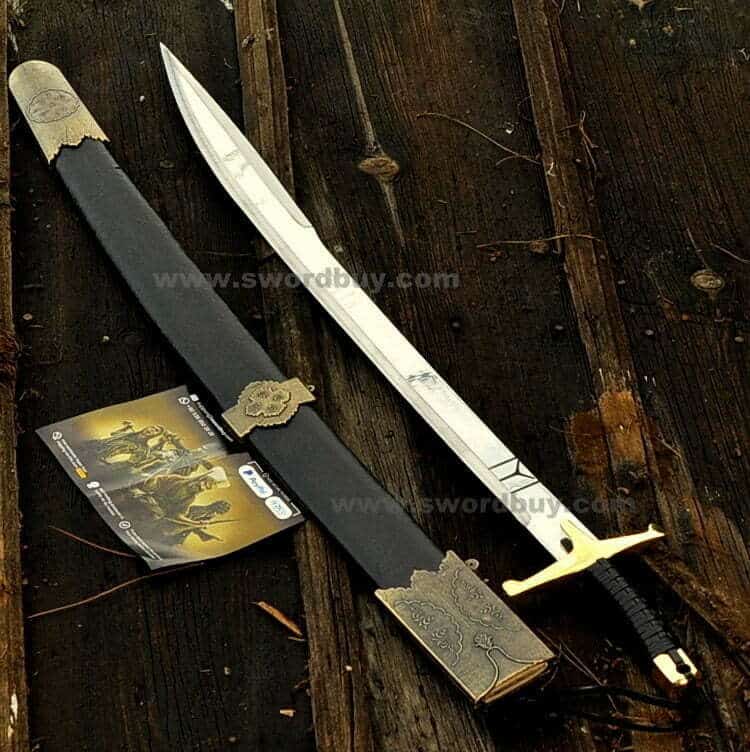The Intricate Process of Modern Sword Design
We invite you to explore the fascinating world modern sword design. This journey will capture your imagination, whether you are a history buff, a martial arts expert, or someone who simply appreciates fine workmanship. Let’s explore the art and technology of swordmaking where tradition meets innovation.
You may be interested in this article. The Fascinating Types of Swords Throughout History
The Evolution of Sword Design
Swords are rich in history. They have evolved from simple tools into complex weapons and symbols. Modern sword designs pay homage to their rich heritage, while also embracing the latest technologies and materials. This fusion produces weapons that are beautiful and highly functional.
From Concept to Creation: the Design Phase
Design is the phase where magic happens. Designers and swordsmiths start with a design concept. This is often inspired by historical or fictional blades, or combat needs. This phase includes:
1. Researchers and inspiration Designers research ancient texts and historical documents, as well as modern combat requirements. They are inspired by legendary swords such as the Japanese Katana, European Longsword or Middle Eastern Scimitar.
2. Sketching and Blueprinting The initial sketches capture the essence the sword. The blueprints outline dimensions, blade curve, handle design and decorative elements. Precision is essential, as minor variations can have a significant impact on the performance and appearance of a sword.
3. The right material is important. Modern swords are often made of high-carbon steel because it is durable and retains its edge well. To increase strength and reduce weight, advanced alloys and composites can be used.
The Blade: Heart of the Sword
The blade is the heart of a sword. The blade is crafted in several steps.
4. Forging the Blade Forging involves heating metal and hammering into shape. Hand-forging and modern techniques, such as hydraulic presses or power hammers, coexist alongside traditional methods. The goal is a flexible and strong blade.
5. Differential hardening This ancient method involves heating the blade, and then quenching in water or oil. The swordsmith can create a blade that has a hard spine and a soft edge by controlling the cooling rate.
6. Grinding and polishing The blade is then ground to determine its final shape, including the geometry of the edge. Polishing is then done to enhance the blade’s aesthetics and functionality. Polishing compounds and high-grit polishing stones create a mirror finish that reduces friction and improves cutting performance.
The Handle: Form and Function meet at the Handle
Handle, or hilt is more than just a grip. It’s a component that impacts balance and control.
7. Tang Design Tang is the part that extends from the blade into the handle. Full-tang designs, in which the tang extends the entire length of the handle and provides superior strength and stability, are available. Hidden tangs can be used to achieve aesthetic appeal, but they require precision engineering in order to ensure durability.
8. Handle materials Wood, leather and synthetic materials are popular choices for handle construction. The warmth and beauty that wood offers, as well as the grip and resilience of synthetics, are all unique. For added style, custom designs may include intricate carvings and inlays.
9. Guard and Pommel A guard (or crossguard), protects your hand from slipping onto the blade. The pommel, located at the end of the handle, counterbalances and balances the blade. It can also be used as a weapon. All of these elements are carefully crafted to complement the overall design.
The Final Assembly: Bring It All Together
The final assembly is required after the blade and handle have been completed.
10. Components must be fitted and assembled with precision. Precision is required to achieve a perfect fit and balance. To secure the handle, Swordsmiths utilize adhesives, pins and traditional techniques such as peening.
11. Sharpening The edge is sharpened to razor-like sharpness. This process takes patience and skill to produce a durable and sharp edge.
12. Testing and Quality Control Each sword is subjected to rigorous testing. The blade is put through stress and cutting tests. Only those swords that pass strict quality standards can be sold.
Modern Sword Design: Innovations
Modern technology has led to exciting innovations in sword design.
13. Computer-Aided Design Software (CAD) allows designers to create detailed models and simulations. This technology allows designers to experiment with new materials and designs.
14. Modern swords can incorporate advanced materials such as carbon fiber, titanium and advanced polymers. These materials have unique advantages, including reduced weight and increased durability.
15. Laser Cutting and Engraving Laser cutting and engraving allows for precise cutting, and adds both decorative and functional elements to modern blades. This allows for unmatched customization and artistic expression.
Custom Swordmaking: The Art of Custom Swordmaking
The pinnacle of modern blade design is the custom-made sword, which is tailored to meet the needs and preferences of each individual user.
16. Custom Swordmakers Work closely with Clients to Create Unique Designs This ensures that the final product reflects the owner’s personal style and needs.
17. Handcrafted Excellence Although modern techniques improve precision, handcrafting is still vital. Each sword is crafted by skilled artisans who add a personal touch, making sure that no two are the same.
18. Functional Art Custom swords, while they are weapons, are also works of art. These custom swords are often decorated with intricate details such as engraved guards and blades. These features showcase the artistry and craftsmanship of the swordsmith.
Future Sword Design
With the constant advancement of materials and technologies, the future of sword designs looks promising.
19. Smart Swords Smart materials and embedded sensors can lead to “smart” swords that adapt to changing conditions and give real-time feedback.
20. Sustainability Practices Sustainable practices are increasing in the swordmaking industry as environmental awareness grows. This includes the use of recycled materials and environmentally-friendly production methods.
Swords: A Timeless Appeal
Modern sword design is an exciting blend of traditionalism and innovation. Each sword is an expression of human ingenuity and is the result of centuries’ worth knowledge and workmanship. Swords are still admired and admired by many, whether they’re used for historical reenactments or martial arts.
We thank you for taking part in this fascinating journey into the complex process of modern blade design. This exploration is intended to deepen your understanding of these timeless weapons, and the artistry that goes into their creation.
FAQs for Sword Design
There isn’t one “most effective” sword design because it really depended on a few things:
- Who was using it? Swords for horseback riding (cavalry swords) were different from those designed for fighting on foot.
- What was their opponent wearing? Swords good against armor wouldn’t be the best against someone in light clothing.
- What fighting style was used? Some swords were better for thrusting, others for slashing.
Here are some examples of effective swords for different situations:
- European Longsword: Great all-around sword for armored knights, used for both slashing and thrusting.
- Japanese Katana: Excellent slashing weapon, known for its sharp single-edged blade.
- Roman Gladius: Short sword designed for close-quarters combat, effective with a shield.
So, the best sword design depended on the specific situation!
For more information about the question you can read this article. How Master Craftsmen Create Iconic Swords
Several sword designs excel at slashing due to their blade shape and weight distribution. Here are some of the top contenders:
- Katana (Japan): This iconic Japanese sword features a curved, single-edged blade. The curvature allows for powerful slashing motions while maintaining good handling. The stiff blade and strong grip also contribute to its effectiveness for delivering devastating cuts.
- Dao (China): Similar to the katana, the dao is a Chinese single-edged sword known for its chopping power. The dao can have a straighter or more pronounced curve depending on the region and era. Its wider blade makes it excellent for heavy slashing attacks.
- Falchion (Europe): This European sword has a single-edged blade that broadens significantly towards the point. This design concentrates the force of a swing into a powerful slash, making it effective against armored opponents.
- Sabre (Europe): Lighter and more curved than the falchion, the sabre was a cavalry sword designed for swift, powerful slashes from horseback. Its single-edged blade and complex guard system made it a favorite among European cavalry for centuries.
- Scimitar (Middle East): This sword features a distinctively curved blade that maximizes the length of the cutting edge. The scimitar’s lightness and agility made it ideal for both slashing and thrusting attacks in close quarters.
Ottoman Sword: Ottoman Swords such as the Yatagan and Kilij, are famous for their craftsmanship, design, and effectiveness in combat. Here’s a glimpse into the rich history of these swords:
- Materials and Craftsmanship: Ottoman swords were crafted using Damascus steel, known for its distinctive patterns and resilience. The blacksmiths of the era were skilled artisans who combined function and art in their creations.
- Design: The Kilij was a prominent Ottoman sword with a slightly curved blade that was sharp and swift. The Yatagan, on the other hand, had a shorter and straighter blade, often used by Janissaries, the elite infantry units.
- Cultural Significance: Ottoman swords were more than just weapons. They were status symbols, gifts to dignitaries, and an integral part of ceremonial attire.
- Modern Appeal: Today, these swords are highly sought after by collectors and history enthusiasts. They not only symbolize the Ottoman Empire’s military prowess but also its cultural and artistic achievements.
Ultimately, the “best” slashing sword depends on the context. Consider factors like the user’s strength, fighting style, and intended use (warfare, self-defense, etc.)
Unfortunately, there is no single “best” sword because it depends on various factors:
- Purpose: Swords designed for combat are different from those for dueling or everyday carry. A battlefield weapon may be too bulky for personal defense.
Period and Place: Different cultures and time periods have developed swords to suit their specific needs and fighting styles.
Individual User: A sword that is ideal for a powerful warrior may be cumbersome for someone with less strength or reach.
Here’s a breakdown of why there is no single best: - Specialization: Swords excel in different areas. A katana may be great for slashing, but a European longsword may be better for both slashing and thrusting against armored opponents.
Personal Preference: Fighting style and comfort play a role. Someone may prefer the agility of a scimitar sword to the strength of a dao sword.
However, some swords are renowned for their effectiveness in certain contexts. Here are a few examples: - Versatility: European Longsword – A versatile sword for armored combat.
Cutting: Katana (Japan), Dao (China) – Famous for their sharp, curved blades. - Stabbing: Rapier (Europe) – Focuses on sharp, piercing attacks.
- Melee: Gladius (Roman) – Short sword for use with a shield.
- Uniqueness: The Ottoman sword is very effective in close combat and is among the best swords due to its unique construction.
Let me know if you would like to learn more about specific sword types or historical periods!
For more information about the question you can read this article. The Fascinating Types of Swords Throughout History
As discussed earlier, there isn’t a definitive “best sword in history” due to the reasons we mentioned before. However, some swords stand out for their exceptional qualities within their historical context:
European Longsword (13th-16th centuries): This versatile sword excelled in both slashing and thrusting, making it a great weapon for armored combat. Its well-balanced design allowed for powerful attacks and good handling in one-on-one duels or larger battles.
Katana (Japan, developed around 14th century): The katana is admired for its beautiful craftsmanship and exceptional cutting ability. Its curved, single-edged blade delivers powerful slashes and can be surprisingly nimble for its size.
Rapier (Europe, 16th-17th centuries): This sword focused on precision and finesse. Its slender blade and complex hand protection made it ideal for thrusting attacks, particularly against opponents with less sophisticated defenses.
These are just a few examples. Other contenders for “great swords” could include the Roman Gladius for its effectiveness in close combat, the Chinese Dao for its heavy chopping power, or the ottoman sword for its curved design and agility.
Instead of a single “best,” perhaps it’s more interesting to explore the rich history of sword design and appreciate how different cultures developed weapons that suited their specific needs and fighting styles.
For more information about the question you can read this article. The History of the Ottoman Sword





